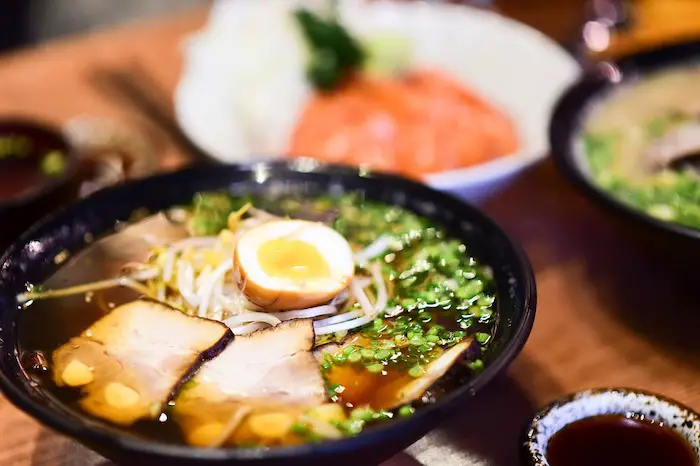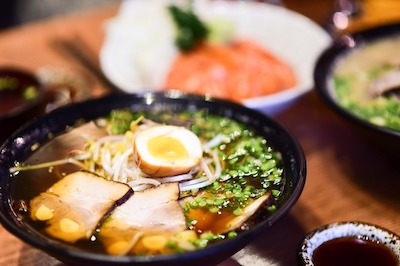We are reader supported. When you purchase through links on our site, we may earn an affiliate commission. Also, as an Amazon affiliate, we earn from qualifying purchases.

What comes to your mind first when you hear ramen? If you cringe then probably you are thinking of the fried instant noodles high in sodium, no vegetables or protein. Those who have tasted the real deal know that it’s quite different from the economy instant packages that you ate as a college student.
So, is Japanese ramen healthy? I would say both No and Yes. The answer is a No if you are talking about the instant pre-packed bricks because they lack nutrition big time. Yes, if you are referring to a steaming bowl of freshly made noodles in broth with green veggies and soft boiled eggs at the top.
Although Japanese ramen has gained immense popularity as an instantly gratifying fast food, most people don’t eat the real thing. Unfortunately, most Americans and people across the world know the dish only from the fried noodles and seasoning packets available at the grocery stores.
What Makes Real Ramen A Better Choice
Nutritionists and food critics will still point their fingers at the high sodium, calorie and fat content in the ramen served at Japanese restaurants. However, they are far better than the pre-packaged and dried stuff in many ways than one. Let’s take a look at the few preliminary differences.
Hand-made
Noodles even in the smallest ramen shops in Japan are incredibly fresh and many famous restaurants hand-make them from scratch. The broth that adds flavor and taste to the noodles are typically made from soy sauce, miso, pork, and salt.
Meat-based broth
Most of the broth flavors are meat-based although you may also find the fish stock in them. The broth is held culprit for having high sodium content, but then many people will only eat noodles and leave the extra broth in the bowl or drink only a part of it. Thus cutting back on the sodium intake.
Veggies

Unlike a packet of instant noodles, a fresh bowl of ramen will include a lot of green veggies such as seaweed, leeks, scallions, bamboo shoots, bean sprouts and so on. Some veggies may be boiled along with the broth while others may be used for garnishing.
Protein-rich
Besides veggies, a bowl of fresh ramen served at restaurants may also include a slice of pork or pieces of tofu. Other options may include soft-boiled egg, hard-boiled egg, raw egg, or fish paste/cake.
Things That Make Ramen Unhealthy
Japanese ramen is typically made of two essential ingredients – wheat noodles and broth (soup). The noodles are typically made from salt, wheat flour, water and kansui, a type of alkaline mineral that contains potassium carbonate, sodium carbonate, and a little bit of phosphoric acid. The presence of kansui lends a firm texture and yellowish hue to the noodles
Talking about the broth or soup, most consumers eating at a ramen shop have no idea what goes into the broth. It may be pork or chicken-based stock, beef bones, pork bones, kombu (kelp), katsuobushi (fish flakes), shiitake and onions, or something else to improve the flavor.
Besides the lack of clarity in the ingredients used for making the broth, the soup base is also high in sodium content. Studies done at Harvard University have shown that consuming an excessive amount of salt can be detrimental for your bones, heart, and blood pressure too.
In some ramen shops, the chef may use braised pork belly for making the broth, and this is high in calories and saturated fat. Butter is also a common ingredient used for enhancing the flavor but it adds to the fat and sodium content.
Ask any ramen fan about Tonkotsu broth and you can see his face light up! It is one of the most delicious broths made by simmering pork bones for hours until all the collagen and fat melt. As per the National Center for Biotechnology Information, bone broth contains a risk of lead contamination.
The other alternatives such as shio ramen and miso ramen are high in salt but comparatively healthier than tonkotsu or lard. The key lies in making the right choices and not overdoing ramen, no matter how much you love it.
Ways To Make Ramen Healthy
The argument against ramen is not meant to make you avoid the dish altogether, but help you find easy hacks to eat it and stay healthy too. One of the best ways to control what goes into your bowl of heaven is to make it at home.
This gives you the liberty to check on the protein, salt, and vegetable content while retaining the umami flavor. You can make healthier choices such as vegetable or whole wheat noodles and low-sodium chicken broth. Turn it into a hearty meal by adding lean meat, eggs, fish, seafood, tofu, and chicken.
Here are some of the 5 amazing creations to try at home:
Low-carb Vegan Ramen
If you are watching your weight or strictly following a Paleo or plant-based diet then here are some easy tweaks for you. Substitute wheat-based ramen noodles with zoodles or zucchini ribbons. It not only increases your veggie intake but also reduces calories.
Keep the sodium level in check by substituting miso paste with a low-sodium broth or reduce soy sauce use to just one teaspoon.
Healthy homemade ramen
A meal made from a pack of instant ramen noodles can be delicious and healthy too. We suggest that you store the packet of ramen in the refrigerator and skip the powdered seasoning packet that comes with it. Use a use-sodium chicken/ pork stock instead.
Layer it up with veggies lying in your refrigerator – carrots, spinach, green onions, mushrooms, and whatever you can find. Reduce calories by adding a lot of other ingredients to a half cup of noodles.
Bright Vegetarian Ramen
Add a pop of color to your ramen by preparing the soup from ingredients like apple cider vinegar and miso paste. You can add carrots, broccolini, and a paste of nuts to enhance the broth. For toppings, you may add soft boiled eggs, tofu, and veggies of your choice.
Sriracha and Daikon Ramen
You may use the firm Asian radish to substitute ramen noodles or I would suggest you do a 50-50 mix to still have noodles in your dish. The stock can be prepared by boiling mushrooms and veggies to keep it light in fat and calories.
Add a little soy sauce to add flavor to broth without overdoing sodium content. A dash of Sriracha can give that much-needed heat so that you don’t miss the lack of salt.
6 Mistakes To Avoid When Eating Japanese Ramen
Just like sushi or other traditional Japanese food, you must follow some etiquettes and avoid mistakes to enhance your experience. A few things people usually do can make a healthy bowl of ramen unhealthy for you, so check them out.
1. Letting your ramen get cold
It’s recommended that you eat your ramen noodles while it’s still hot to enjoy the freshest flavors and optimized texture. The noodles are always dipped in a hot broth which means if you don’t eat quickly, they may overcook and turn bland.
Your approach to a hot bowl of ramen should be the same as a steaming cup of coffee. If you don’t consume instantly, you will spoil the taste. The food quality may also go bad and become unhealthy if left outside for too long.
2. Not untangling the noodles
When ramen is served to you, the noodles are usually clumped together in a coil. Spend some time to untangle the coils and it becomes easier when you pick the strands. Otherwise, you will end up with a huge clump that will not fit your mouth.
If you have rigid chopsticks, you should have no problem untangling your noodles. In some places, you may get a Chinese spoon called renge to hold beneath the noodles while eating.
3. Take only as much you can handle
This is a continuation of the above tip – so you should pick only as much noodles in your chopsticks as you can handle. We suggest that you follow the rule of taking less than how much you think that you may want.
If you are unable to take in all that you can pick, you will need to bite to cut the noodles short. The remaining part will fall into the bowl, which is gross for those around you.
4. Not slurping
Contrary to what many people may believe, slurping the broth is not bad manners. In Japan, it is expected for people to slurp as it helps cool down the noodles and soup. If you can’t slurp it then this means the dish is too dry or not rich enough.
When you want to do it healthy, we suggest that you always opt for the less fatty and delicate soy sauce-flavored shoyu. You don’t need to slurp all the soup or broth after you eat noodles to reduce your sodium intake.
5. Not being careful about toppings
When you order ramen in a restaurant, sometimes you get to choose what you want as toppings. Make the right choices to get a healthier bowl. Some people like to stick with the minimalist approach with an egg on the top.
However, if you would like to try new flavors or make your bowl more filling without being unhealthy, pick toppings wisely. Some examples are green onions, tofu, yellow corn, seaweed, and so on.
6. Skipping the drink after ramen
When you eat a bowl of ramen, you should always follow it with a good amount of water or some other beverage of your choice. As perhaps you already know, there’s a high amount of sodium in the broth, so drinking lots of water should help neutralize the effect.
In Japan, they offer a black oolong tea to help customers digest pork broth in tonkotsu ramen. If you are looking for healthier options, we would suggest that you avoid the fatty tonkotsu and choose a low-sodium, less-fatty broth with ramen.
Related Questions
How can I make instant ramen noodles healthier?
There are several low-sodium options available, choose them, and skip the highly flavored packs as they contain a lot of preservatives. Pile up your bowl with a lot of green veggies, and protein options like eggs shredded chicken, tofu cubes, or pork meat slice.
Related Article: Can You Make Ramen In The Microwave? (Guide)
What is the nutritional value of ramen?
A bowl of Japanese ramen available at the resultants typically includes 2,858 mg of sodium, 1,241 calories, and 69 grams of fat. According to the FDA, an average adult should not consume over 2,300 mg of salt per day. So, there you have the stats in front of you. The trick is to eat all noodles and leave the remaining broth to cut back on sodium intake.
Does that mean we should stop eating ramen?
Not at all, because there are many low sodium and less fatty options available. Sometimes, the servers will accommodate your request. If they don’t and you are concerned about your health, go to some other ramen shop where you can get a healthier option. Alternatively, you may consider making ramen at home with lots of veggies and a light broth with less sodium.

